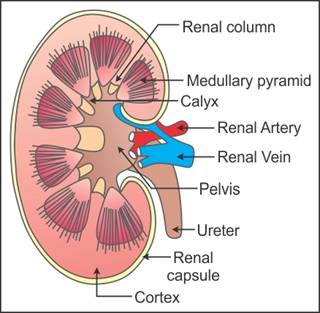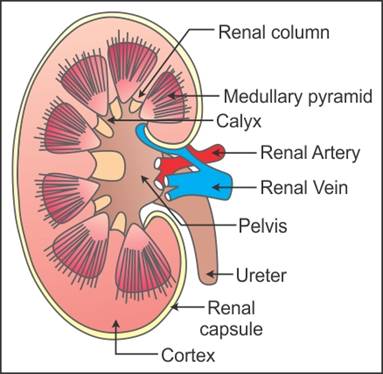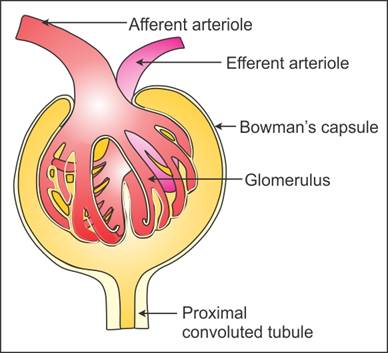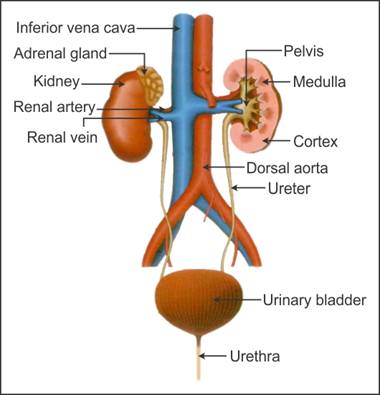Q1. Name a vasoconstrictor which increases the glomerular blood pressure.
Solution
Angiotensin II
Q2. The proximal convoluted tubule (PCT) is lined with
Solution
The walls of the proximal convoluted tubule (PCT) consist of a single layer of simple cuboidal cells bearing microvilli on their surface and resting on a basement membrane.
Q3. Name the enzyme secreted by the juxtaglomerular cells.
Solution
Renin
Q4. When a fresh water protozoan
possessing a contractile vacuole is placed in a glass containing marine
water, the vacuole will
Solution
When freshwater protozoa are placed in marine
water (hypertonic), the contractile vacuoles disappear because of the absence
of endosmosis. So, water does not enter the protoplasm.
Q5. Explain micturition.
Solution
The process of release of urine is called micturition.
When the urinary bladder gets filled with urine, the stretch receptors
present on the walls of the bladder send signals to the central nervous
system (CNS).
In response to these signals, CNS sends the motor message which causes
the contraction of smooth muscles of the bladder and simultaneous relaxation
of the urethral sphincters. This results in the release of urine from the
body.
Q6. What are podocytes?
Solution
Podocytes are the epithelial cells which line the Bowman’s capsule.
Q7. How much blood is filtered per minute by the kidneys?
Solution
1100-1200 ml
Q8. In protozoa such as Amoeba and Paramecium, an osmoregulatory organelle
is
Solution
Amoeba and Paramecium
use the contractile vacuole for excretion. These are freshwater animals (hypotonic
solution). Water flows from the outside to the inside of the body of the
organism. The contractile vacuoles in these organisms collect excess water
and gradually increase in size. When the vacuoles reach a critical size, they
contract, squeezing out their contents through the process of diffusion.
Q9. Describe the internal structure of the kidney.
Solution
Internal structure of the kidney:
 The kidney is a bean-shaped structure.
Internally, it is divided into an outer cortex and an inner medulla.
The medulla is in the form of medullary pyramids.
Medullary pyramids are projected into the calyces.
The cortex which extends between the medullary pyramids is called
columns of Bertini.
The kidney is a bean-shaped structure.
Internally, it is divided into an outer cortex and an inner medulla.
The medulla is in the form of medullary pyramids.
Medullary pyramids are projected into the calyces.
The cortex which extends between the medullary pyramids is called
columns of Bertini.
 The kidney is a bean-shaped structure.
Internally, it is divided into an outer cortex and an inner medulla.
The medulla is in the form of medullary pyramids.
Medullary pyramids are projected into the calyces.
The cortex which extends between the medullary pyramids is called
columns of Bertini.
The kidney is a bean-shaped structure.
Internally, it is divided into an outer cortex and an inner medulla.
The medulla is in the form of medullary pyramids.
Medullary pyramids are projected into the calyces.
The cortex which extends between the medullary pyramids is called
columns of Bertini.
Q10. Name the disorder in which glucose is present in excess quantities in
urine.
Solution
Glycosuria
Q11. Explain the renin-angiotensin mechanism.
Solution
A fall in glomerular blood pressure activates the juxta glomerular cells to release renin.
Renin converts angiotensin, first to angiotensin I and then to angiotensin II.
Angiotensin II increases the glomerular blood pressure which increases the glomerular filtrate rate (GFR).
At the same time, angiotensin II activates the adrenal cortex to release aldosterone.
Aldosterone stimulates the reabsorption of sodium ions and water from DCT. This also results in an increase in GFR.
Q12. The kidney of an adult frog
is
Solution
A mesonephric kidney
consists of a large number of tubules which develop internal glomeruli
enclosed in capsules forming Malpighian bodies. In
amphibians, it is functional in both embryo and adult.
Q13. In Hydra, waste material of
food digestion and nitrogenous waste material are removed from
Solution
In Hydra, undigested residues are egested from the
coelenteron through the mouth, while ammonia is
removed through the general body surface.
Q14. A patient suffering from
cholera is given saline drip because
Solution
The cholera toxin from Vibrio cholerae causes a series of metabolic reactions—continuous
activation of adenylate cyclase
of intestinal epithelial cells. The high concentration of c-AMP triggers
continual secretions of Cl−, HCO3− and water into the lumen of the intestine. Administration of saline
not only supports the Na-K pump through which water in the cell is restored,
but glucose is also symported along with sodium.
Q15. What is sweat? What does it contain? State its function.
Solution
Sweat is a watery fluid secreted by the sweat glands located in the
skin. Sweat contains NaCl, urea in small amount and
lactic acid.
Functions of sweat:
Sweat facilitates the cooling effect on the body surface.
It helps to remove some excretory substances from the body such as
lactic acid, urea etc.
Q16. Describe the structure of the Malpighian body.
Solution
The Malpighian body constitutes the glomerulus and Bowman’s capsule.
The glomerulus is a tuft of blood capillaries.
The afferent arteriole enters the glomerulus, while the efferent
arteriole leaves the glomerulus.
The Bowman’s capsule is a cup-shaped structure.
The glomerulus is situated in the cup-shaped depression of the
Bowman’s capsule.
Q17. What is uraemia? Name and describe the process used to remove waste
substances from individuals suffering from uraemia.
Solution
Uraemia is the accumulation of urea in the blood due to malfunctioning
of the kidneys.
In individuals suffering from uraemia, the waste substances are
removed by haemodialysis.
In this process, blood is drained from the convenient artery (usually
radial artery), mixed with anticoagulant such as heparin and pumped into the
dialysing unit.
The dialysing unit consists of a coiled tube surrounded by a dialysing
fluid.
The dialysing unit has the same composition as that of the plasma
membrane, but it does not contain any nitrogenous waste.
The absence of nitrogenous water in the dialysing unit enables the
easy movement of waste from urine into the tube through the porous membrane,
thus clearing the blood from any waste.
The cleared blood is then pumped back into the body through the same
vein after adding anti-heparin.
Q18. What is the juxtaglomerular apparatus?
Solution
The juxtaglomerular apparatus is a sensitive region which is formed
due to the cellular modifications in the distal convoluted tubule and the
afferent arteriole at the region of their contact.
Q19. State in one line as to what happens in following disorders:
Renal calculi
Glomerulonephritis
Solution
Renal calculi - An insoluble mass of crystals
of oxalates is formed in the kidneys.
Glomerulonephritis - Inflammation of glomeruli
of the kidneys.
Q20. If kidneys fail to reabsorb water, the effect on tissue would
Solution
If kidney fails to reabsorb water, the concentration of urine will be low and urination will be more frequent. This condition is called polyuria. In this condition, the tissues of the body will be dehydrated and shrink.
Q21. Explain how the glomerular filtration rate is maintained by the kidneys?
Solution
Maintenance of the glomerular filtration rate is carried out by the juxtaglomerular apparatus in the kidneys.
It is the region formed by the close contact between the distal convoluted tubule and the afferent arteriole at a region.
When GFR falls, it stimulates JGA to release rennin.
Renin helps to bring reduced GFR back to normal.
Q22. State the function of protonephridia in amphioxus.
Solution
Protonephridia in amphioxus maintain the ionic and fluid volume, i.e. protonephridia play an important role in osmoregulation.
Q23. The condition of failure of
the kidney to form urine is called
Solution
The condition of failure of the kidney to form urine
is called anuria.
Q24. Study the given figure and label 1, 2, 3 and 4. Also state the difference between the cortical nephrons and juxta medullary nephrons.


Solution
1 - Glomerulus
2 - Proximal convoluted tubule (PCT)
3 - Bowman’s capsule
4 - Distal convoluted tubule (DCT)
Cortical Nephron
Juxta Medullary Nephron
Loop of Henle is short.
Loop of Henle is long.
Loop of Henle extends little into the medulla.
Loop of Henle extends deep into the medulla.
Q25. What is ketonuria?
Solution
Ketonuria is a disorder in which ketone bodies are observed in the
urine. It is an indication of diabetes.
Q26. Solenocytes are the main
excretory structures in
Solution
Solenocytes are meant for excretion and osmoregulation
in Platyhelminthes.
Annelids have metanephridia for excretion.
Molluscs have kidneys for excretion.
Echinoderms possess no excretory organs as
excretion occurs by osmosis or diffusion.
Q27. Malpighian tubules are
Solution
Insects, centipedes,
millipedes and arachnids have Malpighian tubules for excretion.
Q28. The liquid which collects in the cavity of Bowman's capsule is
Solution
The glomerular filtrate which collects in the Bowman’s
capsule contains only corpuscles and plasma proteins. The filtrate is
protein-free and cell-free plasma in composition and osmotic pressure.
Q29. Name the columns of the cortex which extends between the renal pyramids.
Solution
Columns of Bertini
Q30. The main function of Henle's loop is
Solution
The main function of Henle's loop is to reabsorb water and important nutrients in the filtrate. Through the counter-current mechanism, it aims to reduce the volume of water and solutes within the urine without any change in its concentration.
Q31. What is vasa recta? State its function.
Solution
Vasa recta is the minute vessel of the peritubular network which runs
parallel to the loop of Henle.
It maintains the concentration gradient in the medullary interstitium
and helps to maintain the osmolarity of blood.
Q32. State the type of epithelium which lines the inner wall of PCT.
Solution
Simple cuboidal brush border epithelium
Q33. Name the three processes involved in urine formation.
Solution
The three processes involved in urine formation are glomerular
filtration, reabsorption and secretion.
Q34. Name the cells which secrete K+ and H+ during urine formation.
Solution
Tubular cells secrete K+ and H+ during urine formation.
Q35. Enteronephric nephridia of earthworms
are mainly concerned with
Solution
In annelids such as earthworms, nephridia are excretory organs. They contain septal nephridia which discharge
the excretory fluid into the intestine. So, these are called enteronephric nephridia.
Q36. State the role of the distal convoluted tubule in urine formation.
Solution
The distal convoluted tubule (DCT) is responsible for the absorption of HCO3− ions and the secretion of H+ ions, K+ ions and ammonia to maintain the pH of urine and the sodium-potassium balance in the blood.
DCT is also responsible for the conditional reabsorption of sodium ions and water.
Q37. Draw a well-labelled diagram of the L. S. of kidney. Label any six
parts.
Solution
L. S. of kidney:


Q38. Haematuria means
Solution
Haematuria means the presence of red blood cells
(erythrocytes) in the urine.
Q39. Name any two classes of uricotelic animals of the phylum Chordata.
Solution
Reptiles and birds
Q40. What structures constitute the Malpighian body?
Solution
The glomerulus and the Bowman’s capsule constitute the Malpighian body.
Q41. Which one of the following options shows a correct matching pair?
Solution
Man - Ureotelic
Birds - Uricotelic
Fish - Ammonotelic
Frog - Ureotelic
Q42. Name the excretory organs in fish.
Solution
Body surface and gills
Q43. Name the excretory organs found in the following organisms:
Earthworm
Liver fluke
Prawns
Cockroach
Solution
Animal
Excretory Organs
Earthworm
Nephridia
Liver
fluke
Flame cells
Prawns
Green/antennal glands
Cockroach
Malpighian tubules
Q44. The yellow colour of urine is due to
Solution
The yellow colour of urine is
due to the pigment urochrome derived from the breakdown of haemoglobin from
worn-out RBCs.
Q45. Name the part of the nephron which is situated in the medulla of the kidney.
Solution
Henle’s loop
Q46. State the function of sebum.
Solution
The sebum provides a protective oily covering which protects the skin.
Q47. Where do you find the slit pores in the Bowman’s capsule?
Solution
Slit pores are present between the podocytes in Bowman’s capsule.
Q48. Name the branch of the renal artery which enters the glomerulus.
Solution
Afferent arteriole
Q49. State the condition in which urea gets accumulated in the blood.
Solution
Uraemia
Q50. The following substances are the excretory products in animals. Choose the least toxic from among them.
Solution
The toxicity of excretory products is as follows:
Ammonia ˃ Urea ˃ Uric acid
Carbon dioxide is a respiratory product and is eliminated through diffusion from the body.
Q51. State the role of Henle’s loop in urine formation.
Solution
Henle’s loop maintains high osmolarity of the medullary interstitial fluid.
Q52. Name the notch present on the inner concave surface of the kidney.
Solution
Hilum
Q53. Different organs perform the role of excretory organs in different animals.
Give the names of such two excretory organs and the names of animals in which these organs are found.
Explain the role of the excretory organ of the cockroach in detail.
What value do you learn from (a)?
Solution
Planaria
Flame cells
Amphioxus
Protonephridia
Earthworm
Nephridia
Antennal
glands Prawns
Cockroach
Malpighian tubules
Malpighian tubules in cockroaches remove the nitrogenous waste products and also maintain the ionic and fluid balance in the body.
Although there are different organs in different animals, they perform the same function. Similarly, there are human beings of different caste and religion. We must not forget that all are equal, and we should treat every person equally well.
Q54. Name the excretory organ of Planaria.
Solution
Flame cells
Q55. Animals which excrete urea produced during metabolism
of amino acids are
Solution
Ureotelic animals - Excrete
urea. Example: Amphibians
Uricotelic animals - Excrete
uric acid. Examples: Reptiles and insects
Ammonotelic animals - Excrete ammonia. Example: Bony fish
Aminotelic animals - Excrete excess of amino acids. Examples:
Molluscs and echinoderms
Q56. Name the functional unit of the human excretory system.
Solution
Nephron
Q57. Describe the criteria for kidney transplantation.
Solution
The patients with terminal renal failure are eligible for kidney transplantation. The persons at risk from a life-threatening disease are not eligible for kidney transplantation.
Q58. Name any two substances which are reabsorbed in the renal tubule by
active mechanisms.
Solution
Glucose and amino acids
Q59. Draw a well-labelled diagram of the renal corpuscle.
Solution
Renal corpuscle:


Q60. State the osmolarity of the filtrate in the medulla of the kidney.
Solution
1200 mOsmoiL−1
Q61. State the function of rennin.
Solution
Renin stimulates the glomerular blood flow to bring the glomerular
filtration rate back to normal.
Q62. Name the three layers through which blood is filtered during glomerular filtration.
Solution
Layers through which blood filters during glomerular filtration are
Endothelium of glomerular blood vessels
Epithelium of Bowman’s capsule
Basement membrane present between the endothelium of the glomerulus and the epithelium of Bowman’s capsule
Q63. Explain the counter-current mechanism.
Solution
The flow of the glomerular filtrate in the two limbs of Henle’s loop and the vasa recta is in a counter-current pattern.
NaCl is transported by the ascending limb of Henle’s loop which is exchanged with the descending limb of the vasa recta.
NaCl is returned to the interstitium by the descending portion of the vasa recta.
Similarly, minute quantities of urea enter the thin segment of Henle’s loop which is transported back to the interstitium by the collecting tubule.
The counter-current pattern and the proximity between the Henle’s loop and the vasa recta help to maintain the osmolarity in the inner medullary interstitium, i.e. 300 mOsmoiL−1 in the cortex and 1200 mOsmoiL−1 in the medulla.
This process is called the counter-current mechanism.
Q64. Distinguish between ammonotelism and uricotelism.
Solution
Ammonotelism
Uricotelism
Waste
products are excreted in the form of ammonia.
Waste
products are excreted in the form of uric acid.
Elimination
of ammonia requires more water.
Elimination
of uric acid requires less amount of water.
Aquatic
amphibians, bony fish and aquatic insects exhibit ammonotelism.
Reptiles,
birds, insects and land snails exhibit uricotelism.
Q65. Name any one animal in which antennal glands act as excretory organs.
Solution
Prawns
Q66. Name the network of the efferent arteriole formed around the renal
tubule.
Solution
Peritubular capillaries
Q67. Name the nitrogenous waste product which requires a large amount of
water for its elimination.
Solution
Ammonia
Q68. Name the neural mechanism responsible for micturition.
Solution
Micturition reflex
Q69. Distinguish between ammonotelism and ureotelism.
Solution
Ammonotelism
Ureotelism
Waste
products are excreted in the form of ammonia.
Waste
products are excreted in the form of urea.
Elimination
of ammonia requires more water.
Elimination
of uric acid requires moderate amount of water.
Ammonia
is highly toxic.
Urea
is less toxic than ammonia.
Aquatic
amphibians, bony fish and aquatic insects exhibit ammonotelism.
Marine
fish, mammals and terrestrial amphibians exhibit ureotelism.
Q70. What is the GFR of a healthy individual?
Solution
GFR (i.e. the glomerular filtration rate) of a healthy individual is 125 ml/minute, i.e. 180 litres/day.
Q71. Distinguish between uricotelism and ureotelism.
Solution
Uricotelism
Ureotelism
Waste products are excreted in the form of uric acid.
Waste products are excreted in the form of urea.
Elimination of uric acid requires less amount of water.
Elimination of uric acid requires moderate amount of water.
It is the least toxic substance.
It is a moderately toxic substance.
Reptiles, birds, insects and land snails exhibit uricotelism.
Marine fish, mammals and terrestrial amphibians exhibit ureotelism.
Q72. Name the disorder which can be diagnosed by the presence of ketone
bodies in urine.
Solution
Diabetes mellitus
Q73. A parrot and a dog were fed only a protein-rich diet. In what forms
would they excrete nitrogenous wastes?
Solution
The parrot will excrete uric acid, while the dog will excrete urea.
Q74. State the osmolarity of the filtrate in the cortex of the kidney.
Solution
300 mOsmoiL−1
Q75. Name the largest gland of the human body.
Solution
Liver
Q76. Draw a well-labelled diagram of the human urinary system.
Solution
Human urinary system:


Q77. What are ammonotelic animals? Give any two examples.
Solution
Animals which excrete nitrogenous waste products in the form of
ammonia are called ammonotelic animals.
Examples: Bony fish, aquatic insects
Comments
Post a Comment